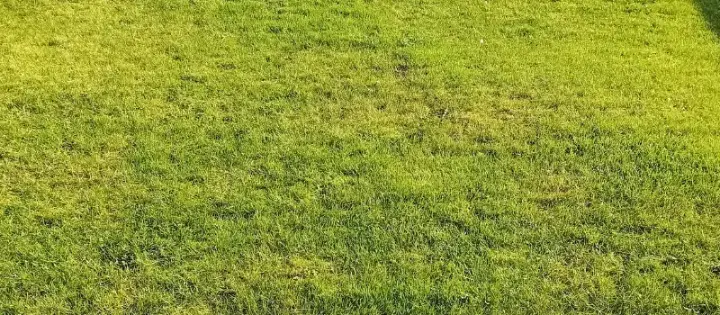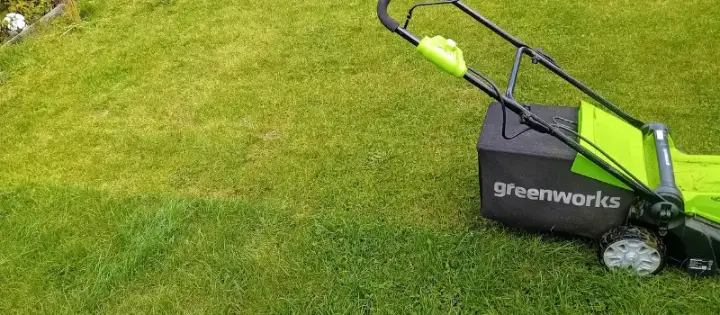Lawn or meadow: Easy-to-follow steps for lawn care

Reviving your lawn naturally can be one of the most rewarding activities in your garden. In this post, you can find easy-to-follow steps for lawn care. In general guide below can be followed in Spring or Autumn. These are the 2 best seasons to give your lawn a bit of love.
After summer my grass looked bad, with dry patches and in some places just visible soil. The colour of the grass was far from green.


Now to set the record straight, I am a gardening enthusiast who likes to care for my garden most naturally. Therefore I act according to seasons, and with natural products and fertilisers. Also, I am a firm believer that simple activity can and will bring results. Often I see massive articles about lawn care with many steps and tools to use, which are scary and may discourage a novice gardener. Given that I created a comprehensive guide below that is simple. Also, the below practice will not take you several days to complete (unless your garden is massive).
A bit of background on lawns:
Over the years lawns have evolved from practical grazing areas to symbols of wealth during Renaissance times to then become the American Dream suburbian identity. Now they are transforming towards more sustainable practices. We are more aware of how to live our lives with less environmental impact, ha! Even better: how to support Mother Nature 🙂
Grass in my garden is just that, in fact, I am a proud owner of grass, moss, clover, and wildflowers. This grass system may be called a meadow and it supports many living organisms such as insects, birds, bees, etc.
However, I still practice good care for my lawn, which in turn gives me a soft, green relaxing space.
Now that summer is over, some of the grass was burnt by the sun, and the soil was compacted with bald patches. Choose a day without excessive wind or rain, being outdoors alone will bust up your endorphins. Here is a step-by-step guide on how to make it green and lush again. Easy-to-follow steps for lawn care.
1. Cutting it
First an optional step, but one from which I started – cut the grass. Mine was a bit too long so I cut it. It helped me see the full picture what’s the state of my lawn. The best place to put cut grass – is your compost 🙂

2. Verticutting
I know I said no crazy tools and now I talk about verticutter. Well, I promise it’s only one and it is an essential one.

Some people use it twice a year, some do when they feel the need. I belong to the second group. Verticutting involves using a machine to cut vertical slits into the soil and grass. It is helping to relieve compaction and promote healthier grass growth. It will also help remove thatch, which is a layer of organic matter and grass that can develop on the soil surface.
Easy-to-follow steps for lawn care: The best time to verticut is in spring or early fall.
Benefits of verticutting are:
- Enhancing water absorption and improved airflow
- Boosts growth of new grass or meadow
- Removes Thatch
An alternative to verticutting may be power raking. On a budget you may try using tools such as a rake or pitchfork to create holes in the earth. It will also remove thatch, and loosen the soil for better water and airflow intake.
You don’t have to buy the machine, especially if like me, you will use it once a year or even every 2 years. Your local gardening center may rent them for affordable prices (often including delivery and pick up to your garden. Or chat up with your neighbour, they may have it 🙂 Good relationship with your neighbour is the key to a happy garden life.
3. Reseeding

Easy step to follow, but how important! You will simply spread seeds on the empty lawn parts, trying to ensure to cover all soil without growth on it. Some people use a seed spreader for more even layers, but using your own hands will work too 🙂 This time I reseeded with grass seeds only, but what I can recommend is clover, native grass, or meadow wildflowers. All of them can work well and they add to your lawns’ diversity. Using a range of seeds often requires less water for maintenance, some of them can be also a pollinator and usually, it is more drought-resistant than growing just grass. My lawn is not strictly grass. It is much harder to keep just grass lawns alive and well. And, to be fair it is not as good for our planet as keeping a meadow. Meadow can enhance both ecological health and the beauty of your outdoor space while requiring less effort to maintain.


Once I saw a post on one of the social media platforms, where a guy posted his perfectly manicured garden photo. Perfect grass, and ideally sized shrubs and flowers. Looked like he used a ruler to make it all pretty. He described all the activities that he performed to keep the place perfect and asked the community what else could he do. Oh, people can be funny online! The majority of them told him to sit on his grass under a tree and enjoy a cold drink. Kudos to him for such an amount of effort, but do we keep our gardens to have another overwhelming side project? Or do we want our green space to feel closer to nature and give us some relaxing moments? Well, that’s a question you may ask yourself, but worth thinking about.
4. Fertilising
Now that you have reseeded your lawn, go over it with a season-appropriate fertilizer:
Easy-to-follow steps for lawn care in Spring
Use a balanced, slow-release fertiliser that contains nitrogen, phosphorus, and potassium (N-P-K). Read the package instructions, but in general, you are looking for a product effective for spring growth. I strongly recommend trying to choose as eco-friendly products as possible.
Easy-to-follow steps for lawn care in Autumn
Choose a fertilizer higher in potassium (the last number in the N-P-K ratio), like 10-10-20. This helps strengthen roots and improve drought resistance.
Remember to spread fertilizer with a spreader or use gloves if you do it by hand.
5. Adding fresh soil
On top of your seeds and fertilizer add a thin layer of topsoil or compost. This will protect your seeds from birds (at least a little), and give them a better environment to germinate and keep moist.
6. Watering
The most important is to water with a gentle stream. You want your seeds to stay where you seeded them (that’s why you also did it on a day without strong wind). See photos for gentle watering streams.


Water regularly – once a day either morning or evening. Since this is an activity performed during Spring or Autumn often you will see that Mother Nature will do your watering job for you when it’s raining. Be thankful 🙂
When the lawn grows and gets stronger, I let the morning dew do its job and only water if there is no rain for a week or so. I also don’t water the lawn daily during the summer – that is my choice and I know not everybody will agree. However, in times of drought and low rain season, I use water collected in my water tanks on my plants, vegetables, and fruit shrubs. Grass will come back as soon as the rains return. It is everyone’s individual choice if during drought season they would use water sourced from their home pipes for lawn care. I tend to not. Especially when we are asked by the local community and authorities to save water.
Once you water the lawn after all the above steps are done, you can relax now. Good news, that’s it for the day’s work. Easy-to-follow steps for lawn care are completed for today.
7. Watch it grow

Hey, you spent a few hours improving your lawn – now every now and then come out, and take a few deep breaths. And see it grow. Germination time varies depending on different factors such as moisture, sunlight exposure, quality of soil and seeds, etc. You should start seeing the first fresh green patches within 2 to 4 weeks. Enjoy – this is such a satisfying moment.

Easy-to-follow steps for lawn care
By following these simple steps, you can create a vibrant, healthy lawn that contributes to the beauty of your outdoor space and supports the environment. Enjoy the process and the results!
Now, turn off the screen and go for a walk. Think of what you have learned about lawn care and when you can put it into action. And enjoy being outside!
Or.. if you want to see one more article – why not check out this <…>
But after that, switch off and go outside – it will do you good! 🙂
With a love for nature,
Anna B-M



